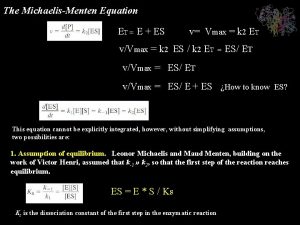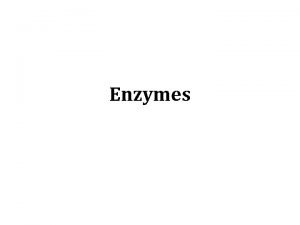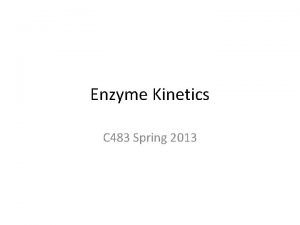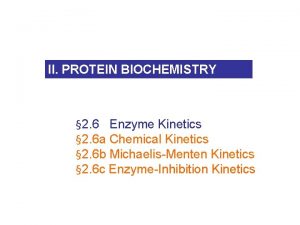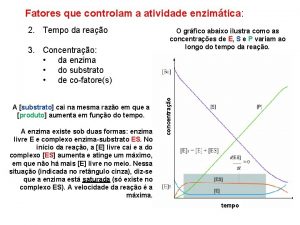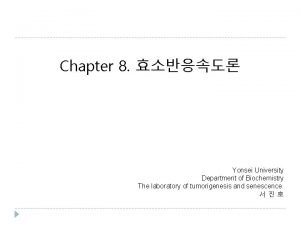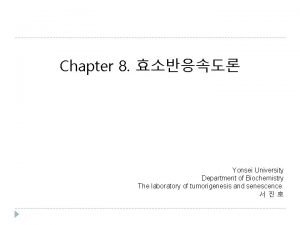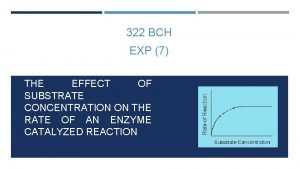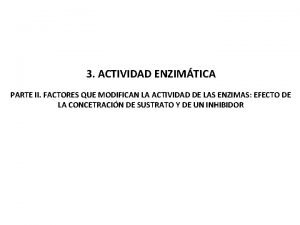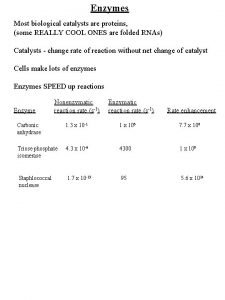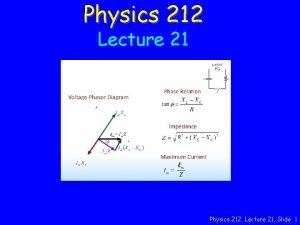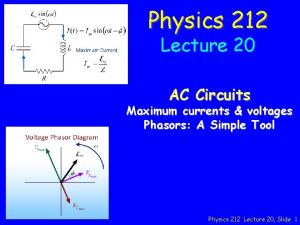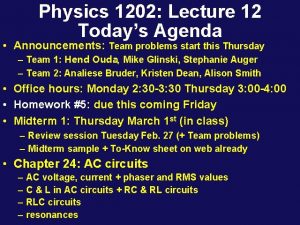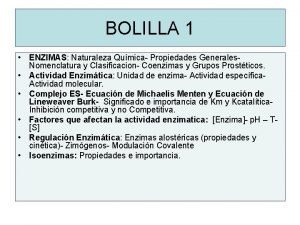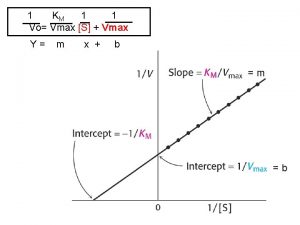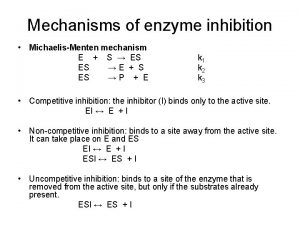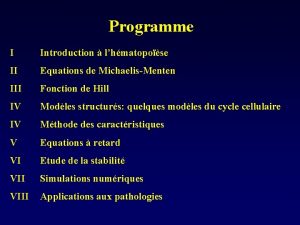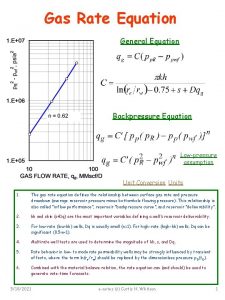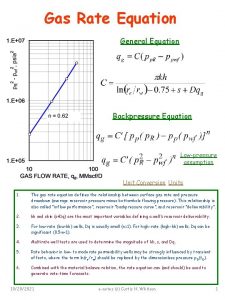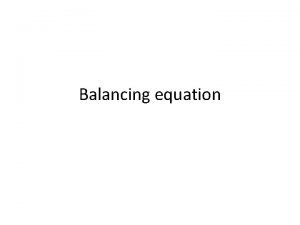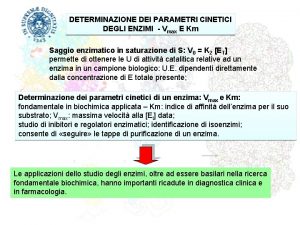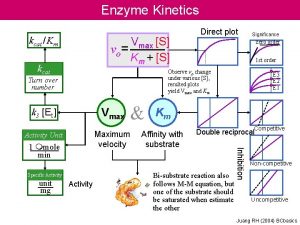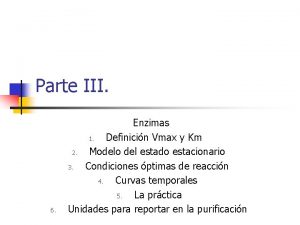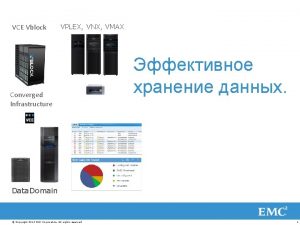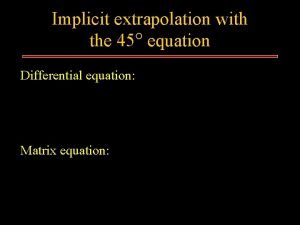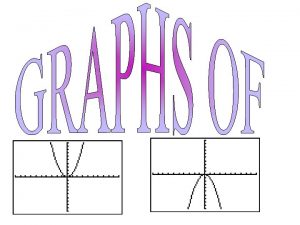The MichaelisMenten Equation ET E ES v Vmax


![The Michaelis-Menten Equation Solving for [ES]: ES = E * S /(k-1+k 2)/k 1 The Michaelis-Menten Equation Solving for [ES]: ES = E * S /(k-1+k 2)/k 1](https://slidetodoc.com/presentation_image_h/8aa75326417a0a28d3d5e5c61d5e91eb/image-3.jpg)
















- Slides: 19

The Michaelis-Menten Equation ET = E + ES v= Vmax = k 2 ET v/Vmax = k 2 ES / k 2 ET = ES/ ET v/Vmax = ES/ E + ES ¿How to know ES? This equation cannot be explicitly integrated, however, without simplifying assumptions, two possibilities are: 1. Assumption of equilibrium. Leonor Michaelis and Maud Menten, building on the work of Victor Henri, assumed that k-1 » k 2, so that the first step of the reaction reaches equilibrium. ES = E * S / Ks Ks is the dissociation constant of the first step in the enzymatic reaction

The Michaelis-Menten Equation 1. Assumption of steady-state. Figure illustrates the progress curves of the various participants in reaction under the physiologically common conditions that substrate is in great excess over Enzyme ([S] » [E]). ES maintains a steady state and [ES] can be treated as having a constant value: The so called steady state assumption, a more general condition that of equilibrium, was first proposed in 1925 by G. E. Briggs and B. S. Haldane
![The MichaelisMenten Equation Solving for ES ES E S k1k 2k 1 The Michaelis-Menten Equation Solving for [ES]: ES = E * S /(k-1+k 2)/k 1](https://slidetodoc.com/presentation_image_h/8aa75326417a0a28d3d5e5c61d5e91eb/image-3.jpg)
The Michaelis-Menten Equation Solving for [ES]: ES = E * S /(k-1+k 2)/k 1 The Michaelis constant, KM , is defined as Therefore: ES = E * S / KM

The Michaelis-Menten Equation The expression of the initial velocity (v 0) of the reaction, the velocity at t=0, thereby becomes v/Vmax = ES/ (E + ES) v/Vmax = (E*S)/Km/ (E + (E*S)/Km ) v/Vmax = S/ Km / (1 + S/Km) v/Vmax = S / Km + S This expression, the Michaelis-Menten equation, is the basic equation of enzyme kinetic. The maximal velocity of a reaction, Vmax occurs at high substrate concentrations when the enzyme is saturated, that is, S>> Km, and ET is entirely in the ES form v= Vmax when

Significance of the Michaelis Constant The Michaelis constant, KM, has a simple operational definition. At the substrate concentration at which [S] = KM, this equation yields v 0 = Vmax/2 so that KM is the substrate concentration at which the reaction velocity is half maximal



Vmax= 10 M/seg Km=10 x 10 -5 M Si en el ensayo se usaron 5 mg/L de preparación enzimática, entonces: v= Vmax = k 2 ET k 2= 10/5 = 2 moles/mg seg ¿Qué predicciones podemos hacer a partir de esta información?

Al iniciar: t = 0, S = So A cualquier tiempo: T=t S=S X = (So-S)/So - d. S/dt = vi = So d. X/dt Graficar por ejemplo : (So – S)/t vs (1/t) ln (So/S)

Two-Stage Catalysis of Chymotrypsin Nitrophenol acetate –NO 2 HO– –NO 2 O C CH 3 COOH O-H C Deacylation (slow step) + H 2 O Kinetics of reaction OC O CH 3–C Nitrophenol O CH 3–C–O– Acylation Two-phase reaction Time (sec) Adapted from Dressler & Potter (1991) Discovering Enzymes, p. 169

DESVIACIONESA M&M d. E/dt = -k 1 E*S + k-1 ES + k 3 ES’ d. ES/dt = k 1 E*S – ES (k-1 + k 2) d. ES’/dt = k 2 ES – k 3 ES’ v = d. P 1/dt = k 2 ES v = d. P 2/dt = k 3 ES’ ET= E + ES’ d. P 2/dt = v = k 3 ES’ v = k 3 k 2 ES / k 3 v = k 2 k 1 E*S / (k-1 + k 2) From the steady state assumption: : d. E/dt = 0 -k 1 E*S + k-1 ES + k 3 ES’ d. ES/dt = 0 ES = k 1 E*S / (k-1 + k 2) d. ES’/dt = 0 ES’ = k 2 ES / k 3 Vmax = k 3 ET Vmax = k 3 (E + ES’) Vmax = k 3 (E + k 1 E*S / (k-1 + k 2) + k 2 ES / k 3 Vmax = k 3 (E + k 1 E*S / (k-1 + k 2) + k 2 k 1 E*S / (k-1 + k 2) / k 3 ) Vmax = k 3 E + k 1 k 3 E*S / (k-1 + k 2) + k 2 k 1 E*S / (k-1 + k 2)

v / Vmax = k 2 k 1 E*S / (k-1 + k 2) k 3 E + k 1 k 3 E*S / (k-1 + k 2) + k 2 k 1 E*S / (k-1 + k 2) v / Vmax = k 2 k 1 S k 3 (k-1 + k 2) + k 1 k 3 S + k 2 k 1 S v / Vmax = k 2 k 1 S k 3 (k-1 + k 2) + k 1 S (k 2 + k 3) v / Vmax = k 2 S / (k 2 + k 3) k 3 (k-1 + k 2) / (k 2 + k 3) + k 1 S = k 2 k 3 ET S / (k 2 + k 3) k 3 (k-1 + k 2) / (k 2 + k 3) + k 1 S v Vmax = k 3 ET


K-2+ Vmax f = k 2 k 3 ET k-2 + k 3 +k 2 Vmax r = k-1 k-2 ET k-1 + k 2 +k-2 Keq = Vmax f * Kp Vmax r * Ks v = Vmax f Kp S – Vmax r Ks P Ks. Kp + Kp. S + Ks. P Ks = k-1 k-2 + k-1 k 3 + k 2 k 3 k 1( k 2 + k-2 + k 3) Kp = k-1 k-2 + k-1 k 3 + k 2 k 3 k-3( k-1 + k 2 + k-2) v = Vmax f S – P / Keq Ks + S + (Ks/Kp) P





 Vmax= k2et
Vmax= k2et Limitations of michaelis menten equation
Limitations of michaelis menten equation Kinetics 483
Kinetics 483 Pseudo 1st order reaction
Pseudo 1st order reaction Vmax shm
Vmax shm Grafica de eadie hofstee
Grafica de eadie hofstee Symmetrix vmax
Symmetrix vmax Vmax and km
Vmax and km Km and vmax
Km and vmax Vmax michaelis menten
Vmax michaelis menten Inhibicion competitiva km y vmax
Inhibicion competitiva km y vmax Vmax=aw
Vmax=aw Wheat germ acid phosphatase km vmax
Wheat germ acid phosphatase km vmax Vmax mmcs
Vmax mmcs Vmax xlimax
Vmax xlimax Vmax xlimax
Vmax xlimax Lcrimax
Lcrimax Vmax= k2et
Vmax= k2et Enzima
Enzima Vrms vmax
Vrms vmax
